I.
It has long been of my curiosity that in addition to biological difference and gender self-awareness, whether the art by women artists also betrays distinguishable feminine characteristics.
Since the rise of feminist movement in the mid-20th century, the West has witnessed a long wave of attacks on the centrality of men in society. Feminists maintain that woman's traditional roles in society, and even the gender differences, are merely the result of construction by a male-dominated society. Echoing this trend, more and more feminist artists come to deny the existence of feminine traits in their works.
In the cultural environment in which to associate women with feminine qualities is frequently called into question, and to say otherwise is easily against the grain, is there a place for art by female artists that embraces femininity? The answer to that question immediately came to me when I first saw Wu Yang's pictures of stones and flower patterns, which are strongly reminiscent of feminine qualities such as of gentle, curvy, flowery and exquisite (fig. 1).
In Wu Yang's pictorial world imbued with femininity, the roughness of stone is replaced by smoothness and luster; In contrast to the usual broad brushstrokes used in oils and ink brush painting, the stones in her works are treated with exquisitely fine touch. In the process of being taken out of natural surrounding and being decorated with flower patterns, stones are imprinted with feminine characteristics and aesthetic preference of the artist.
Why is Wu Yang so keen on painting stone and flower pattern?
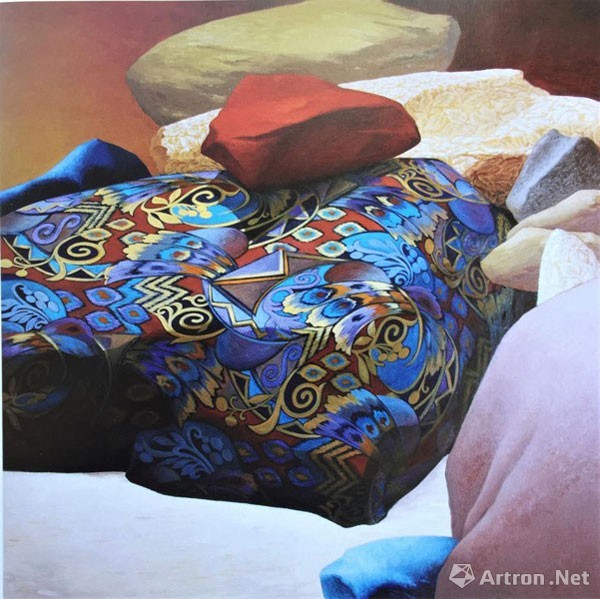
Fig. 1. 2008
II.
Long before she was known for her painting, Wu Yang had distinguished herself in areas of pattern design, fashion design, and later in book illustration.
Wu Yang's artistic career coincides with China's open-up and economic reform starting in the 1980s. She began study in drawing from an early age. And her early interest in pattern design dates back to the years when she went to a local art & design school in Beijing and later worked as a pattern designer. It was during this time that she familiarized herself with the diverse styles of pattern design from all over the world, especially those of Europe and Japan.
In 1985 she was accepted into the graduate program at the prestigious Central Academy of Arts & Design in Beijing, with a focus on pattern design under the tutelage of the renowned art educator Li Mianlu. During this period, she also greatly benefited from the academy's free artistic atmosphere, enhanced by the presence of some top artists in the country such as Pang Xunqin, Wu Guanzhong, Zhang Ding and Yuan Yunfu at the time.
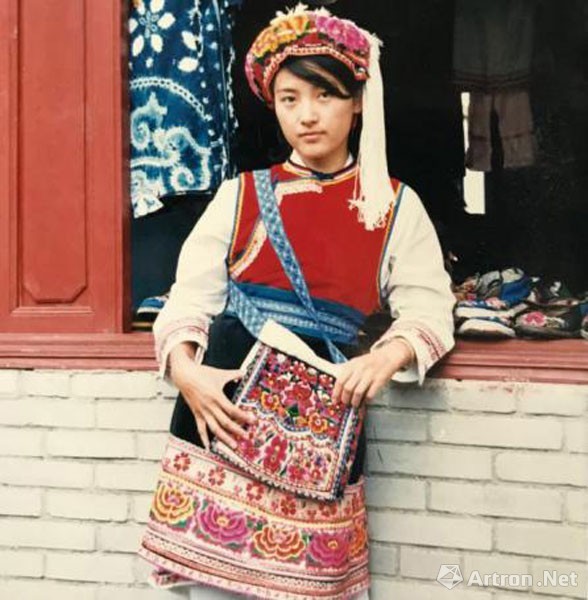
Fig.2. Wu Yang in the CAAD period
After graduating from CAAD and being a faculty member there, Wu Yang moved on to study fashion design in London in 1991 and later returned to China to start a company with her own fashion brand. In the meantime Wu managed to develop her interest in visual art, which eventually led to the creation and publication of six illustrated books on traditional Chinese culture, subsequently presented as gifts for her two young daughters (fig. 3). From these marvelous illustrations we catch a glimpse of Wu Yang's ingenuity in pattern design, decorative colors and handling of details, which inadvertently forecasts the direction and promise of her later success in painting.
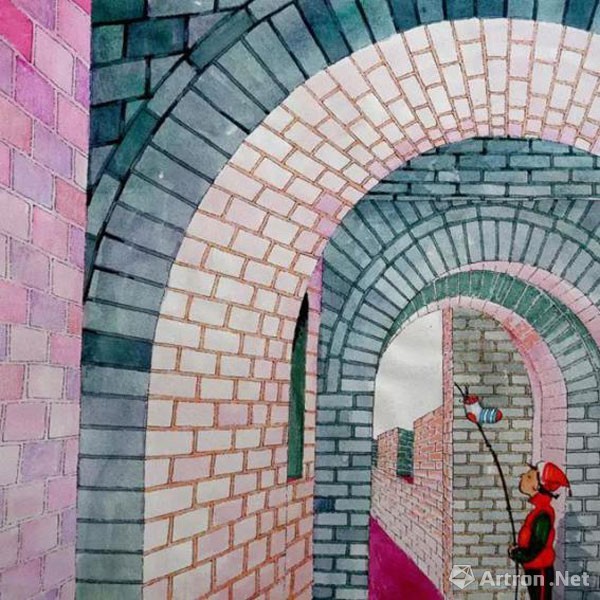
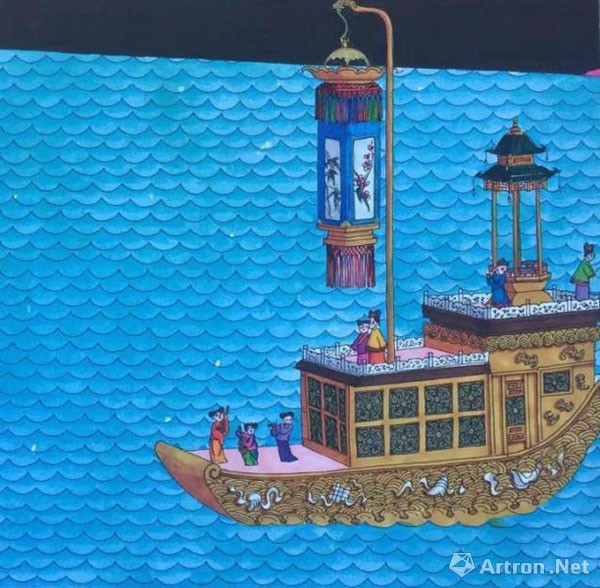
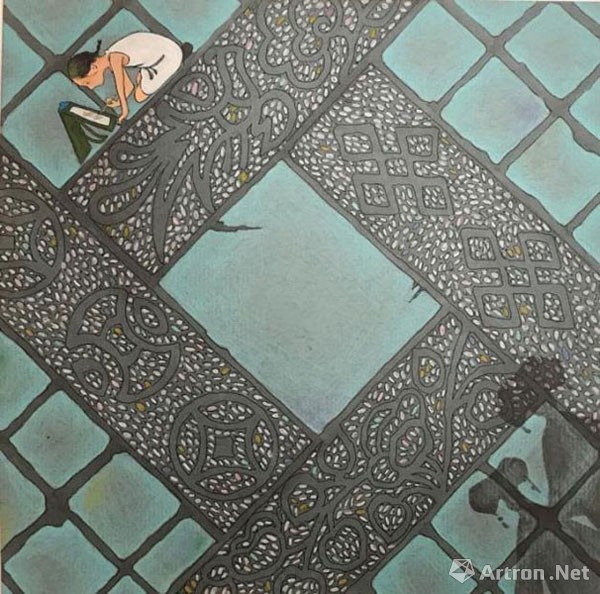
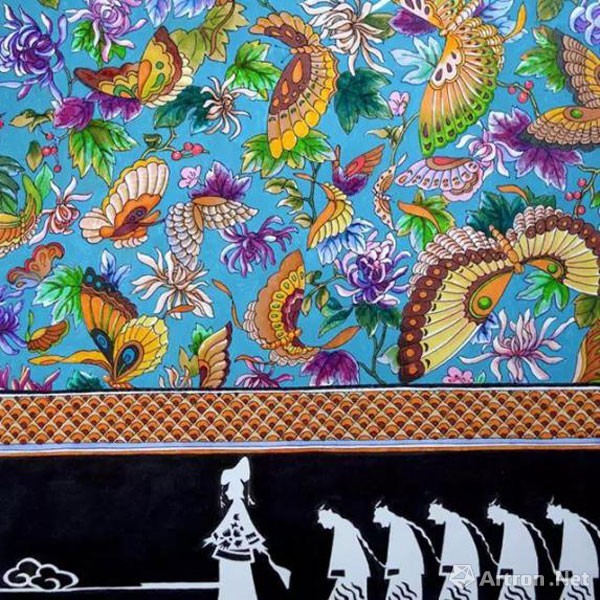
Fig. 3. from book illustrations
But it wasn't till 2006 when she had sold her fashion business and migrated to Canada that Wu Yang began to pursue painting in earnest.
After Wu Yang first moved to Canada in 2006, she had left behind her a successful career in design and business. And now she had to stay at home to look after her two young daughters. When they were away to school she could find time to do something she liked. Painting is what she felt at home at last and it was from this time that she started painting seriously. But what to paint? In front of her house and in the surrounding area near the ocean, there are a lot of pebble stones, which appear in Wu Yang's life day in and day out. As time passed the images of the stones left deep impression on her subconsciousness, and they naturally came to her mind when she picked up the brush.

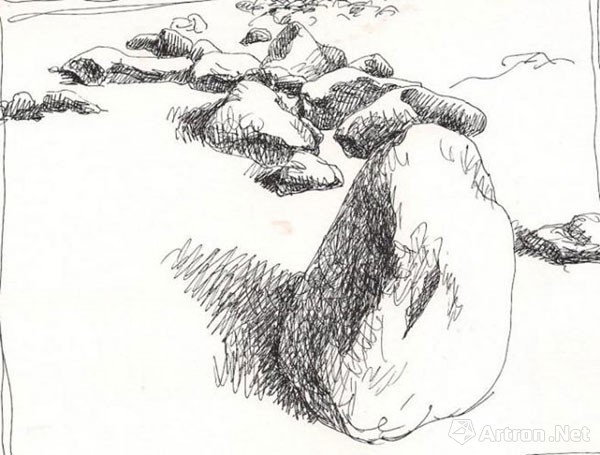
Fig. 4. Pebble stones near Wu Yang's home in Vancouver and her pencil study of stones
There are two things need to be said about her painting of stones. First, their various shapes, sizes and arrangements provide her with various pictorial sources. Secondly, from the very beginning Wu Yang would cover the stones with flower patterns, a practice seemingly unusual to many but most natural to her. As early as the time she studied pattern design at school, she would train herself by observing the patterns on the clothes of women she found on streets and later reconstructed the patterns in drawing from memory. These early experiences with pattern design have evolved into a way of visual thinking for her and made ways into her subconsciousness. In a sense it has become her second nature. As a result it exerts a great influence on the way she looks at and paints her subjects.
Actually this was not the first time Wu Yang applied patterns on objects. As early as 2004 when she did a conceptual work named To Dress up Home for a magazine , she covered the furniture, carpet, statue and her daughter's clothes with patterns. As she once explained, if it had been possible, she would have covered just about everything in surrounding with her favorite graphic patterns (fig. 5).
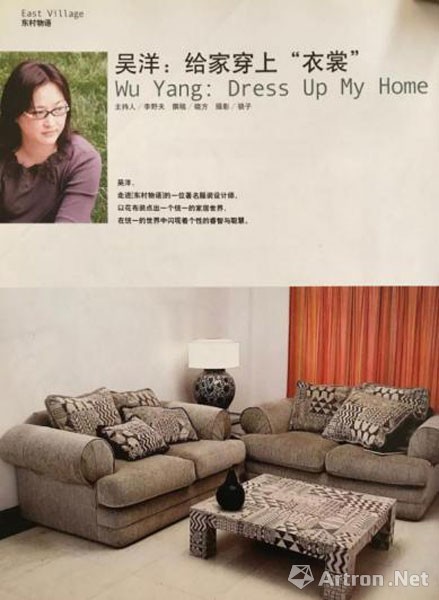
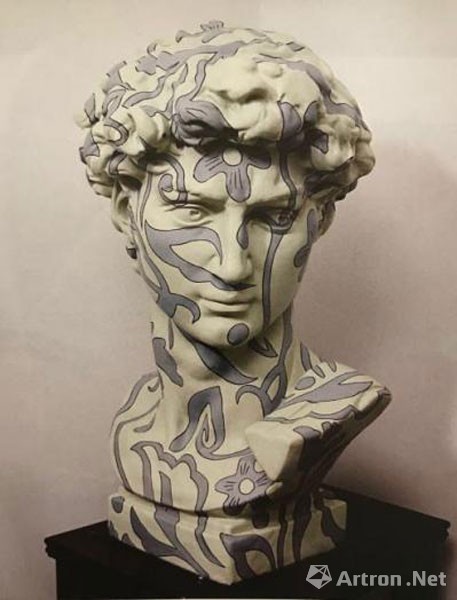
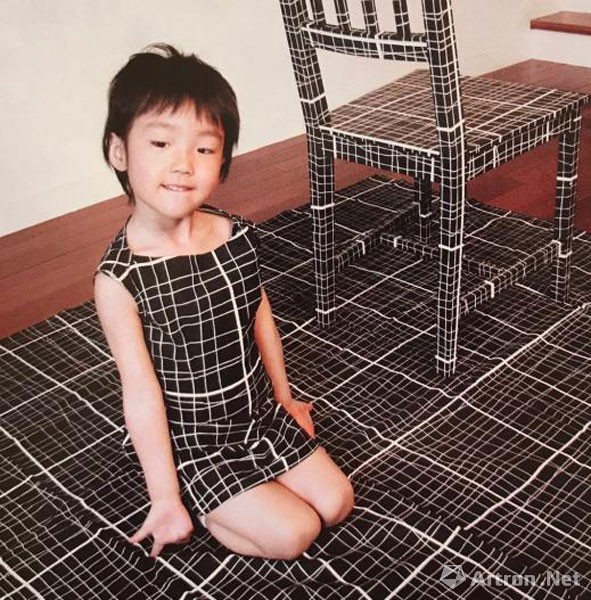
Fig. 5. To Dress up Home
It hadn't taken long before Wu Yang realized that the patterns are perfectly compatible with the forms of stones in her painting, and her long passion for pattern design seems to have finally found a suitable place in shapes of stone. Thus the images of stone covered with patterns have been the subject in her paintings ever since.
As she wrestled with the images of stone and flower patterns, Wu Yang has achieved some very interesting pictorial effects. Take a look at the work named Impression (fig. 6). In composition, the stone at foreground sets against of a group of stones in the background; The picture plane is divided diagonally with warm colors on the left and cold colors on the right; The stone at front is treated with a sense of three-dimensional effect, while the stone immediately behind is flat and whose outline is barely indicated. In Hawaii, the black area is the extension of the shape of stone at foreground; The patterns delineated with golden lines, form contrast with the black area and at the same time echo the golden background (fig. 7) . Perhaps the rich combination of stone and flower patterns is most felt in Black and White Game. Using only black, white, and gray tones, the artist creates a great variety of flower patterns on surface of stones with exquisite details and finish (fig. 8 ).
Till this point in Wu Yang's painting, stones have been taken out of original context and covered with graphic patterns, thus completing a process from natural to cultural state, and becoming her unique visual symbol. In short, stones and patterns have become a whole.
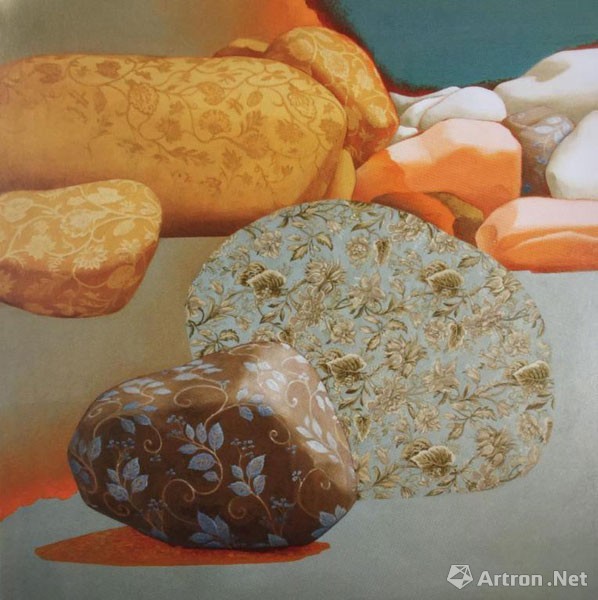
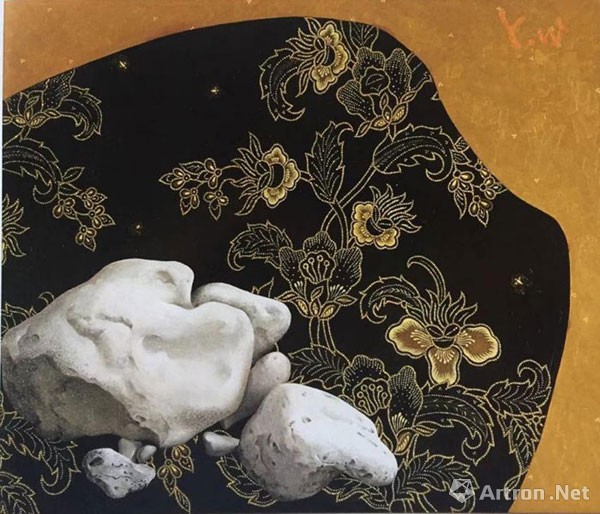
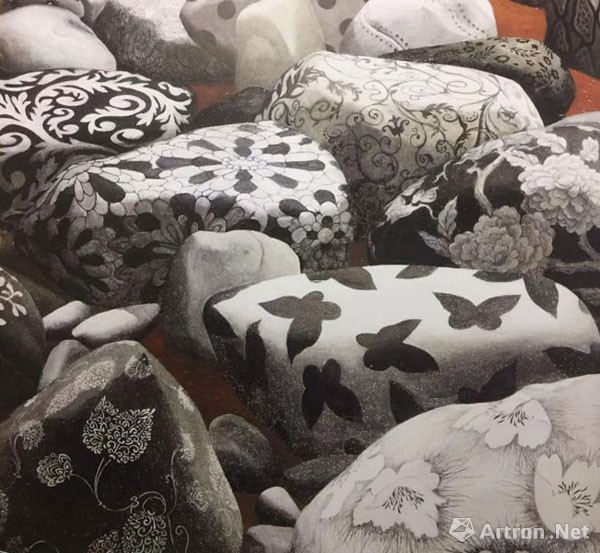
fig. 6. Impression, 2006 Fig. 7. Hawaii, 2008 fig. 8. Black and White Game,2009
III
Wu Yang often likens painting to the path to finding spiritual home. This can be interpreted as that there lies artist's deeper pursuit behind the act of painting. At first I wasn't totally convinced. Can painting stones and flower patterns establish connection with the soul?
Actually Wu Yang's art goes way beyond depicting stones and flower patterns. Having created her unique images of stones and flower patterns, in the ensuing works, she would place the stones in different settings, thus creating interaction with the environment, and leaving greater room for imagination by the viewers. The shift of space leads to a change of context, thus results in new meanings.
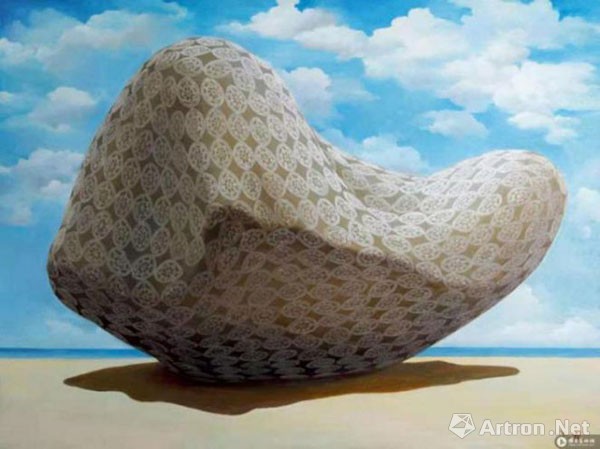
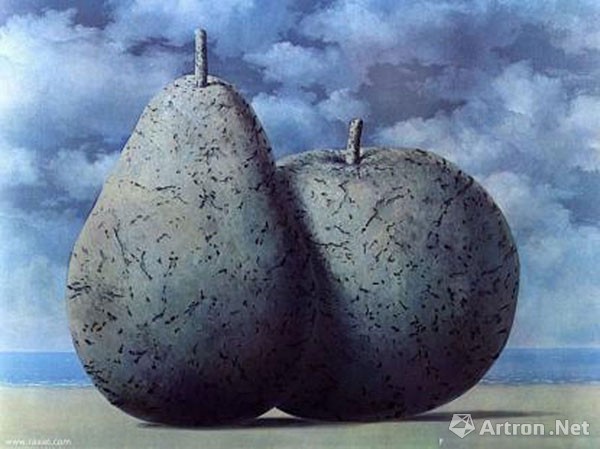
Fig. 9. Salute to the Great Masters, 2010 fig. 10. Rene Magritte's painting
In Salute to the Great Masters, the stone is greatly enlarged, almost to the point of filling the picture plane. The horizon is lowered to further set the rock off. There is nothing except the giant rock in the vast and empty background. The combination of unreal scene with realistic representation means creates a mysteriously surreal effect (fig. 9 & 10).
Those familiar with the works of Belgian artist Rene Magritte can see his influence on Wu Yang. The former uses the change of proportion and texture in de-familiarizing the common scenes, thus creating a surreal effect. From Magritte, Wu Yang learns to move beyond the stones and flower patterns to a broader and imaginative space. In the process the interaction of images with surrounding generates unexpected effects and meanings. The painting earned for her the opus award from Federation of Canadian Artists.
Encouraged by the success, Wu Yang went on to paint anther work with even stronger Surreal effect (fig. 11). We see a giant rock hovering in the air, and flower pattern on the surface mysteriously falling off to turn into real flower buds; The background is filled with dark clouds, suggesting something ominous is imminent and consequently creating a sense of drama.
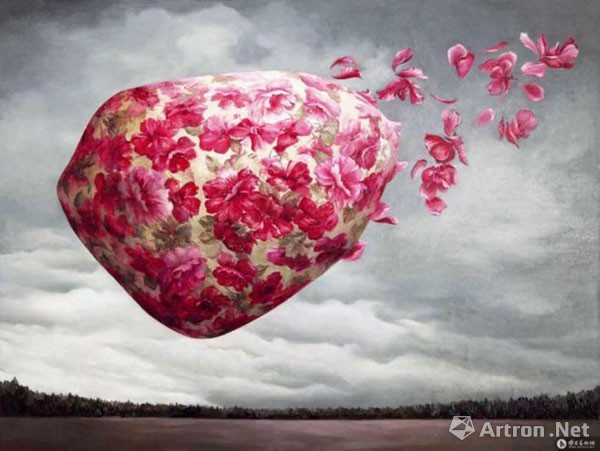
Fig. 11 2010
But Wu Yang didn't indulge in this kind of surreal effect for long. Next she moved to paint more realistic surroundings. The subject in Granville Bridge (fig. 12) is based on a popular tourist spot in Vancouver, a place with a lot of restaurants, cafes, and shops. As Wu Yang often passed by the area, the image of the bridge left a deep impression on her. By putting a huge pattern-covered stone on the structure of the bridge in her picture, it somehow alters the latter, making a familiar landmark appear strange to its local residents, thus changing the way local people see and experience the bridge.
The way of drawing inspiration from real scenes continued in Beijing - I (fig. 13). The gray sky and empty building is the impression Wu Yang had when she returned to Beijing from clear-sky Vancouver. The leaves have almost fallen off completely; the trees have only a few tiny branches left, which can barely support the giant stones on top; even her colorful flower-patterned stone now has lost its usual luster and now wrapped with black stripes of fabric. Alluding to the reality of Chinese cities, the picture is a subtle commentary on familiar scenes of demolition and environmental pollution as result of the rapid transformation of the city.
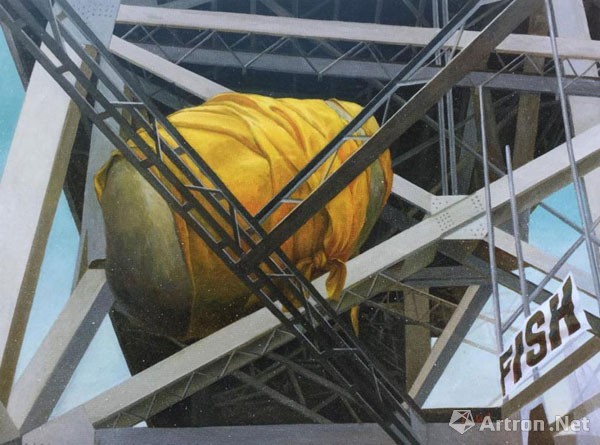
Fig. 12. Granville Bridge, 2011
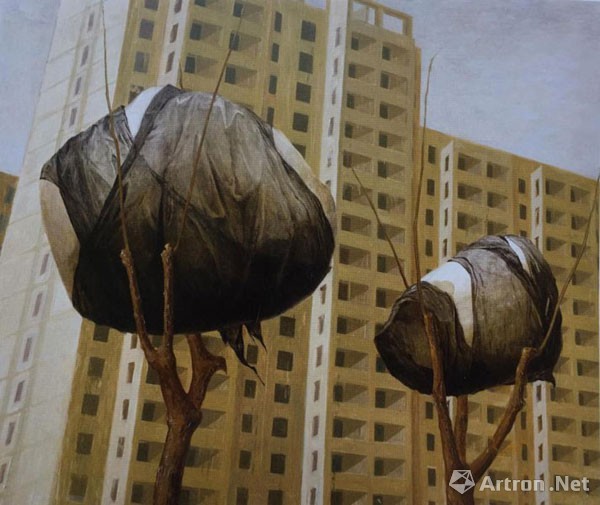
Fig. 13. Beijing - I, 2012
However, Wu Yang did not stop the effort for searching. As I was imaginatively wandering through the surreal and realistic scenes in her work, Wu Yang again took me by surprise to the world of traditional Chinese landscape painting, from there I was delighted to find her flower-patterned stones.
What has made her become interested in traditional landscape? These paintings that setting her patterned stones in landscape, in the artist's words, is a dialogue between ancients and herself. In the space of traditional landscape paintings, Wu Yang fells quite at home and enjoyable. From an artistic point of view, stones are important component of landscape, and both pattern and ink painting are to some extent stylized art forms. In a spiritual sense, the realm of landscape painting presents Wu Yang with an ideal place, which is far from the trouble of the mundane world, and ideally more in line with world of purity, quietude and solitude she desires.
When Wu Yang incorporates her flower-patterned stones into landscape painting, what has she brought to the latter? It is no exaggeration to say that Wu Yang has imbued traditional landscape painting which is traditionally representative of male aesthetic preference with some feminine elements. In the black and white ink painting that emphasizes simple elegance, she adds luster of colors; Into rough and broad brushstrokes, she adds exquisite details and fine touch. We also see a compromise between the feeling of solitude and warmness of home; There is also a sense of co-existence of classical taste of the past and fashion of today. If one looks carefully, one can find the scan code in lieu of artist's seal. This is Wu Yang's way of telling the viewers that the painting is a dialogue between her and the artists of the past (fig. 14-16).
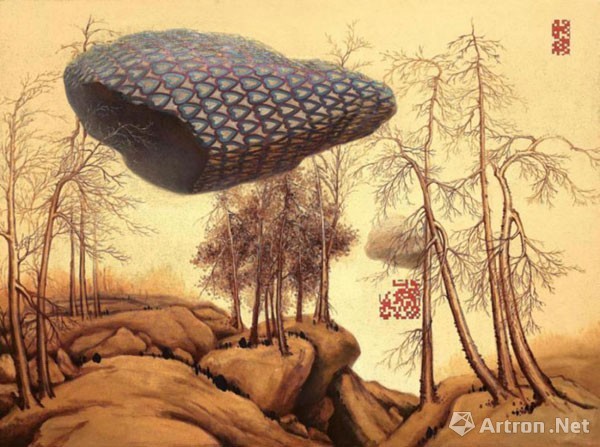
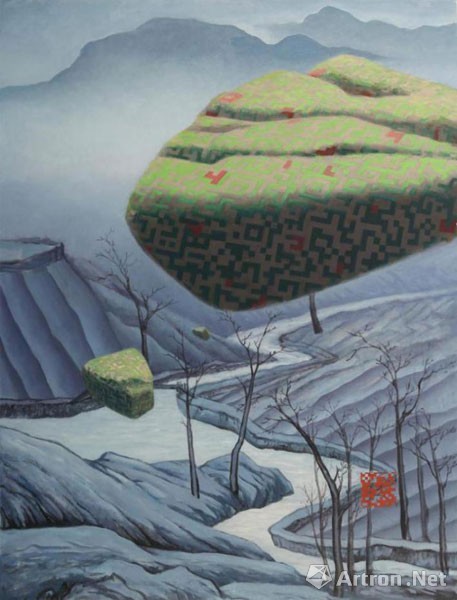
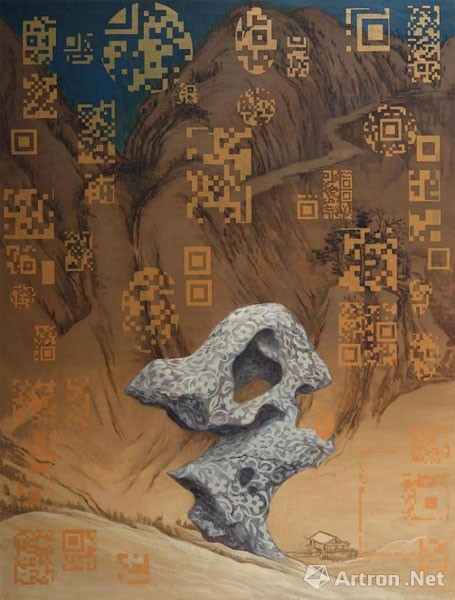
Fig. 14-16
IV
In the past ten years Wu Yang has shown tireless interest in painting stone and flower patterns, without concerning the short-term acceptance or success.
When it comes to using flowers and patterns in painting, the first artist comes to mind is Botticelli of Renaissance Italy. In his best known work Primavera, as the symbol for spring season, flowers and flower patterns appear not only on the clothes of Venus and Flora, the goddess of flowers, but also on the ground, trees and in bushes. (fig. 17)
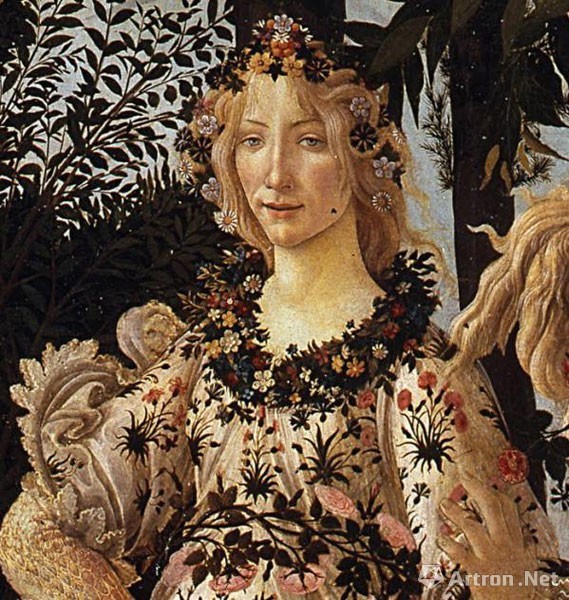
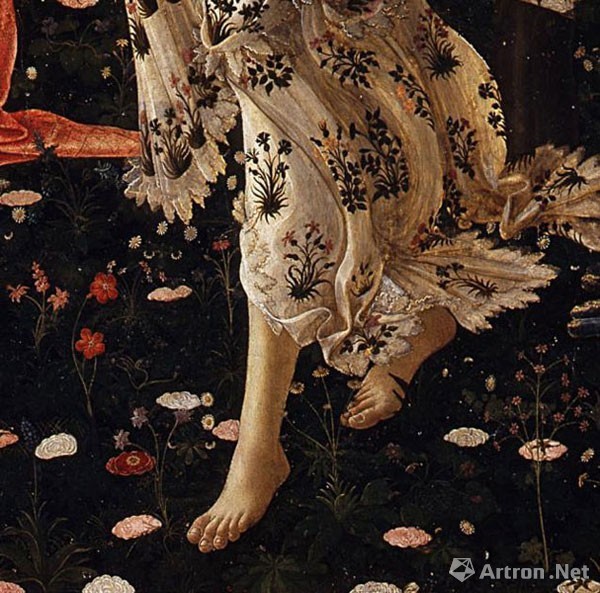
Fig. 17. Botticelli, Primavera
It is really rare in the history of western painting to give such prominence to flowers and flower patterns in a figure painting. In modern time Austrian artist Klimt is the one who uses flower patterns extensively in his works, in which different shapes are treated as flat patterns, spreading all over the picture plane, and becoming independent existence (fig. 18). If Klimt has taken natural forms out of original context and turned them into flat patterns, in contrast, Wu Yang has incorporated patterns into three-dimensional stones and brought them back to nature.
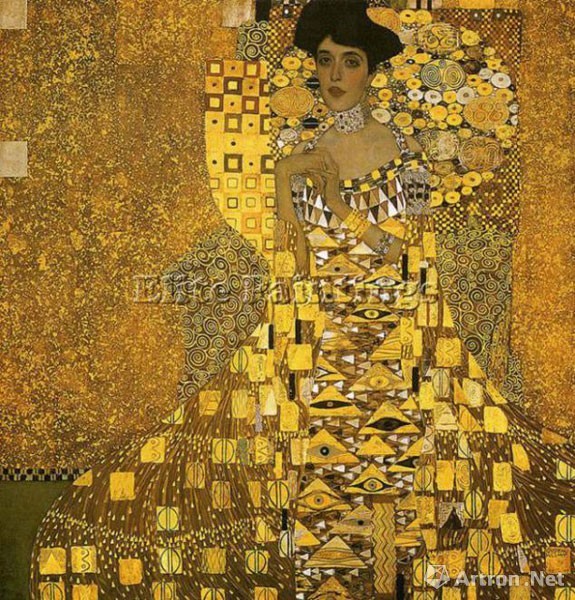
Fig. 18. Klimt fig.
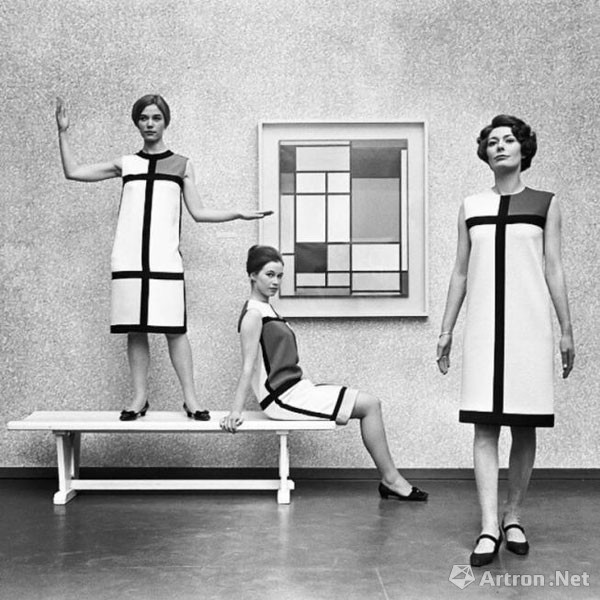
19.Fashion inspired by Mondrian's painting
In the first half of the twentieth century, Mondrian used black grids and pure colors to visualize his understanding of the world. And unexpectedly his abstract paintings inspired a stream of modern designs in furniture, fashion and graphic art (fig. 19). About a century later, seemingly reversing the effort of Mondrian, Wu Yang incorporates design into painting.
Wu Yang's painting has gone through a process of moving from aesthetic object to cultural symbol--from obsession with stones as object, through placing them into surreal, realistic and cultural contexts.
I once asked her what the thinking is behind these transformations. Wu Yang did not answer me directly, but described a scenario instead: a little girl carrying a precious thing she loves runs through places. She put it here and leave it there, and asks herself: "What is the thing that I am carrying? Is it the soul that still finds no home? .... to some extent, I am that girl." Wu Yang's answer sounds a bit like philosophical introspection, but nonetheless reveals the fact that sometimes artistic creation is ineffable. We may interpret her words this way: the thing the little girl carries is in abstract sense her dream, and is in pictorial sense the images of stone and flower pattern. After creating these images, Wu Yang has been looking for a proper place for them to rest. Sometimes she seem to have found it, then she continues the search.
The searching still continues......
Copyright Reserved 2000-2024 雅昌艺术网 版权所有
增值电信业务经营许可证(粤)B2-20030053广播电视制作经营许可证(粤)字第717号企业法人营业执照
 京公网安备 11011302000792号粤ICP备17056390号-4信息网络传播视听节目许可证1909402号互联网域名注册证书中国互联网举报中心
京公网安备 11011302000792号粤ICP备17056390号-4信息网络传播视听节目许可证1909402号互联网域名注册证书中国互联网举报中心
网络文化经营许可证粤网文[2018]3670-1221号网络出版服务许可证(总)网出证(粤)字第021号出版物经营许可证可信网站验证服务证书2012040503023850号